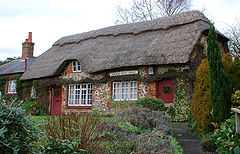Slindon
| Slindon | |
 Slindon post office |
|
 Slindon | |
| Area | 12.86 km2 (4.97 sq mi) [1] |
|---|---|
| Population | 590 [1] 2001 Census |
| - Density | 46 /km2 (120 /sq mi) |
| OS grid reference | SU961084 |
| - London | 49 miles (79 km) NNE |
| Civil parish | Slindon |
| District | Arun |
| Shire county | West Sussex |
| Region | South East |
| Country | England |
| Sovereign state | United Kingdom |
| Post town | ARUNDEL |
| Postcode district | BN18 |
| Dialling code | 01243 |
| Police | Sussex |
| Fire | West Sussex |
| Ambulance | South East Coast |
| EU Parliament | South East England |
| UK Parliament | Arundel and South Downs |
| |
Slindon is a small village and civil parish in the Arun District of West Sussex, England, nestling in woodlands (much of it belonging to the National Trust) on the southern edge of the South Downs. Slindon lies approximately seven miles north-east of Chichester. The closest postal town is Arundel.
Village
The village is listed in the Domesday Book of 1086 as "Eslindone", the name having the probable meaning in Old English of "sloping hill". [2]
St Mary's 12th-century parish church contains a memorial to Stephen Langton (c1150–1228), the Archbishop of Canterbury who attended the signing of Magna Carta. In the Middle Ages Slindon House (now Slindon College) was the site of one of the Archbishop's residences. In 1330 Thomas de Natindon, who was a legal representative of the Pope, was sent to Slindon to serve a writ on the archbishop. His party were not well received by the archbishop's servants who stripped and bound them, then threw cold water over them, apparently with the archbishop's consent. Natindon escaped and was pursued over the hills to Petworth where he was caught and held in prison for three days.[3]
The writer Hilaire Belloc (1870–1953) lived in the village.
In the mid-18th century, Slindon Cricket Club achieved fame through the excellence of its team which featured Richard Newland (1718–91), whose memorial is also in the church.
Slindon post office was closed by Royal Mail in 2008, and the nearest post office is at Walberton, 1.9 miles (3.1 km) away; the local shop and pub have also closed.[4][5]
In May 2012, the process began of renovating and converting the old village forge into a shop, cafe and information centre; this opened on 16th October 2012. [6]
The village has been called the "pumpkin capital of Britain", and an annual display of pumpkins attracts tourists to the village.[5]
A short walk from the village is Nore Folly (aka Slindon Folly), a structure built during the 18th Century by the Newburgh Family whose seat was at Slindon. The Folly resembles a gateway but leads to nowhere.[7]
References
- ↑ 1.0 1.1 "2001 Census: West Sussex – Population by Parish". West Sussex County Council. Retrieved 1 April 2009.
- ↑ Mills, A.D., Dictionary of English Place Names (Oxford 1991, revised 1996)
- ↑ Peter Jerrome, Petworth. From the beginnings to 1660. The Window Press 2002 p31-32
- ↑ "Decisions On The Future Of Post Office Branches In Sussex". Royal Mail. 29 January 2008. Retrieved 11 October 2008.
- ↑ 5.0 5.1 Wintle, Angela (11 October 2008). "The pumpkin king's crowning glory". Telegraph.co.uk. Telegraph Media Group. Retrieved 11 October 2008.
- ↑ http://www.slindonforge.co.uk/
- ↑ "The Folly and Trig Point, Nore Hill". Geograph site - sponsored by Ordnance Survey. Retrieved 20 March 2012.
External links
![]() Media related to Slindon, West Sussex at Wikimedia Commons
Media related to Slindon, West Sussex at Wikimedia Commons
| |||||||||||